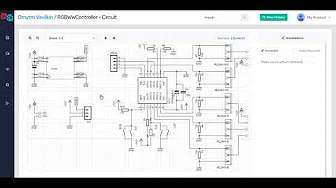Files
Scanning the repository...
README.mdBlocks With Screens PCB Files
Components
The blocks are made up of 3 components.
OLED Board

This board is responsible for all the circuitry to drive a SSD1351 OLED display. This design is heavily based on Adafruit's breakout board for the same display.
It consists of a 13V boost regulator to provide the required voltage to drive the OLED, as well as necessary passive components required by the OLED's datasheet.
Microcontroller Board

This board is a mounting point for the ESP12 microcontroller and the MMA8452Q 3-axis accelerometer. It also has unpopulated pads for a SparkFun Qwiic connector and a WS2812B RGB LED if you want to add additional functionality.
USB Board

This board is responsible for: * Providing a USB serial interface for programming the microcontroller (with automatic reset) * Providing regulated 3.3V power to the Microcontroller and OLED * Providing charging circuitry to charge the LiPo battery
This board is based on various Adafruit LiPo charging boards and USB powered boards with the simplest (by part count) USB-serial chip we could find.
PCB Hacking
We hope you'll open up your blocks and add new functionality or boards we never even dreamed of.
The pin layout is compatible with the Wemos D1 Mini (available on your usual internet shopping sites) so any shields made for those should work!
There is un unpopulated SparkFun Qwiic connector on the microcontroller board. If you solder on a Qwiic connector (just a 4-pin JST connector) you can connect your board to any of the dozens of Qwiic compatible peripherals (e.g. sensors, screens, GPS) out there.
There's an unpopulated spot on the Microcontroller board for a WS2812B RGB LED (or similar). This might come in handy if you want to, say, cut a window in the side of your block and trick it out with colors inside. Note that these LEDs will typically initialize to a random color so if you add the LED, but don't use it in your program, it will probably be lit up to a random color.
You could also add PCBs for different microcontrollers, different screens, or maybe even make a USB-C version! This was meant to be modular. Have fun, and share back what you build!
Manufacturing Boards
We used OshPark for creating our prototype PCBs which we then soldered by hand or in a reflow oven. We used PCBWay to mass manufacture assembled PCBs.
There's an included script for exporting the Eagle PCB files in a bill-of-materials (BOM) format that PCBWay accepts.
Changelog
OLED Board V5
- Revert the revert to go back to VIN for the 13V boost circuit as it didn't seem to have any effect. And this lightens the load on the 3.3V regulator. This is effectively the same design as OLED Board V3.
USB Board V5
- Turn the battery connector counter-clockwise by 90 degrees to avoid wires hanging off the side of the board and not fitting in the block.
OLED Board V4
- Revert back to using 3.3V for the 13V boost circuit to hopefully avoid issues I've seen twice now with the OLED screens developing bad vertical lines of pixels. This is what Adafruit does in their board; perhaps there's a reason for it.
USB Board V4
- Use thicker (power) trace for 3.3V
- Make the USB side slots wider to comply with PCBWay
- Add a JST-SH connector (SM02B-SRSS-TB) for the battery
Microcontroller Board V3
- Attach 3.3V to the ESP12 (doh!)
OLED Board V3
- Uses
D4/GPIO2forOLED DCinstead ofD1/GPIO5since that pin is I2CSCK.
Microcontroller Board V2
- Fixed disconnected decoupling capacitor.
- Added optional header for MMA8452QR1 accelerometer.
- Added optional Qwiic header for SparkFun accessories.
- Added optional 5050 NeoPixel pad.
USB Board V3
- Fix width of power trace going to the switch.
OLED Board V2
- Uses
D1forOLED DCinstead ofD6(MISO) so we don’t have to hack SPI.c for hardware SPI. - Uses
VINfor power for the 13V boost (possible this will reduce the flicker, especially during low battery). - Removed the 3-pin SPI jumper since we didn’t use it.
- Move all the screen capacitors closer to the screen connector (even smaller chance of reducing flicker)
USB Board V2
- Removed oscillator and move to using the
CH340Cinstead ofCH340GUSB-UART chip. - Connect
VCCon theCH340Cchip (fix error from V1). - Move most parts to the front of the board for easier manufacturing.
- Add an optional on LED.
- Add pads for a switch.











